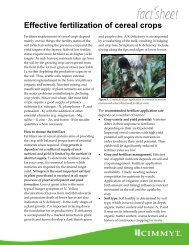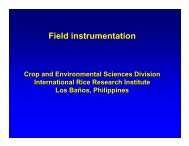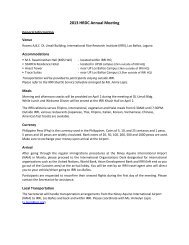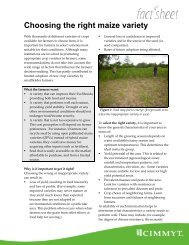Water management in irrigated rice - Rice Knowledge Bank ...
Water management in irrigated rice - Rice Knowledge Bank ...
Water management in irrigated rice - Rice Knowledge Bank ...
- No tags were found...
You also want an ePaper? Increase the reach of your titles
YUMPU automatically turns print PDFs into web optimized ePapers that Google loves.
consumption (Hamilton 2003). Many traditionalfestivals and religious practices are associated with<strong>rice</strong> cultivation and <strong>rice</strong> fields are valued for theirscenic beauty.4.2 Environmental impactsThe production of lowland <strong>rice</strong> affects the environment<strong>in</strong> negative ways, such as the emissionof greenhouse gases and water pollution. In thissection, environmental impacts that have a relationshipwith water and the hydrology of <strong>rice</strong> fields aresummarized.4.2.1 Ammonia volatilizationAmmonia (NH 3) volatilization from urea fertilizeris the major pathway of N loss <strong>in</strong> tropical flooded<strong>rice</strong> fields, often caus<strong>in</strong>g losses of 50% or more ofthe applied urea-N (Buresh and De Datta 1990).Ammonia-N emissions from lowland <strong>rice</strong> fields areestimated to be roughly 3.6 Tg per year (comparedwith a total of 9 Tg y −1 emitted from all agriculturalfields), which is some 5−8% of the estimated 45−75Tg of globally emitted ammonia-N per year (Kirk2004). The magnitude of ammonia volatilizationlargely depends on climatic conditions, field waterstatus, and the method of N fertilizer application.Volatilized ammonium can be deposited on theearth by ra<strong>in</strong>, which can lead to soil acidification(Kirk 2004) and un<strong>in</strong>tended N <strong>in</strong>puts <strong>in</strong>to naturalecosystems.4.2.2 Greenhouse gasesIrrigated <strong>rice</strong> systems are a significant s<strong>in</strong>k for atmosphericCO 2(Chapter 4.1), a significant sourceof methane (CH 4), and a small source of nitrousoxide (N 2O). In the early 1980s, it was estimatedthat lowland <strong>rice</strong> fields emitted some 50−100 Tgof methane per year, or about 10−20% of the thenestimated global methane emissions (Kirk 2004).Recent measurements, however, show that many<strong>rice</strong> fields emit substantially less than those <strong>in</strong>vestigated<strong>in</strong> the early 1980s, especially <strong>in</strong> northern Indiaand Ch<strong>in</strong>a. Also, methane emissions have actuallydecreased s<strong>in</strong>ce the early 1980s because of changes<strong>in</strong> crop <strong>management</strong> such as a decreased use oforganic <strong>in</strong>puts (Van der Gon et al 2000). Currentestimates of annual methane emissions from <strong>rice</strong>fields are <strong>in</strong> the range of 20 to 60 Tg, be<strong>in</strong>g 5–10%of total global emissions of about 600 Tg (Kirk2004). The magnitude of methane emissions from<strong>rice</strong> fields is ma<strong>in</strong>ly determ<strong>in</strong>ed by water regime andorganic <strong>in</strong>puts, and to a lesser extent by soil type,weather, tillage, residue <strong>management</strong>, fertilizer use,and <strong>rice</strong> cultivar (Bronson et al 1997a,b, Wassmannet al 2000). Flood<strong>in</strong>g of the soil is a prerequisitefor susta<strong>in</strong>ed emissions of methane. Mid-seasondra<strong>in</strong>age, a common irrigation practice adopted <strong>in</strong>major <strong>rice</strong>-grow<strong>in</strong>g regions <strong>in</strong> Ch<strong>in</strong>a and Japan,greatly reduces methane emissions. Similarly,<strong>rice</strong> environments with an uneven supply of water(for example, those suffer<strong>in</strong>g from water scarcity,Chapter 1.7) have a lower emission potential thanfully <strong>irrigated</strong> <strong>rice</strong>.Few accurate assessments have been made ofemissions of nitrous oxide from <strong>rice</strong> fields (Abao etal 2000, Bronson et al 1997a,b, Dittert et al 2002),and the contribution to global emissions has not yetbeen assessed. In <strong>irrigated</strong> <strong>rice</strong> systems with goodwater control, nitrous oxide emissions are quitesmall except when excessively high fertilizer-Nrates are applied. In <strong>irrigated</strong> <strong>rice</strong> fields, nitrousoxide emissions ma<strong>in</strong>ly occur dur<strong>in</strong>g fallow periodsand immediately after flood<strong>in</strong>g of the soil at the endof the fallow period.4.2.3 <strong>Water</strong> pollutionChanges <strong>in</strong> water quality associated with <strong>rice</strong> productionmay be positive or negative, depend<strong>in</strong>gma<strong>in</strong>ly on <strong>management</strong> practices such as fertilizationand biocide (all chemicals used for crop protection,such as herbicides, pesticides, fungicides, etc.)use. The quality of the water leav<strong>in</strong>g <strong>rice</strong> fields maybe improved as a result of the capacity of the <strong>rice</strong>fields to remove nitrogen and phosphorus (Feng etal 2004, Ikeda and Watanabe 2002). On the otherhand, nitrogen transfer from flooded <strong>rice</strong> fields bydirect flow of dissolved nitrogen through runoffwarrants more attention. High nitrogen pollutionof surface fresh waters can be found <strong>in</strong> <strong>rice</strong>-grow<strong>in</strong>gregions where fertilizer rates are excessivelyhigh, such as <strong>in</strong> Jiangsu Prov<strong>in</strong>ce <strong>in</strong> Ch<strong>in</strong>a (Cuiet al 2000).Contam<strong>in</strong>ation of groundwater may arisefrom the leach<strong>in</strong>g of nitrate or biocides and theirresidues (Bouman et al 2002). Nitrate leach<strong>in</strong>gfrom flooded <strong>rice</strong> fields is quite negligible becauseof rapid denitrification under anaerobic conditions(Buresh and De Datta 1990). For example, <strong>in</strong> thePhilipp<strong>in</strong>es, nitrate pollution of groundwater under<strong>rice</strong>-based cropp<strong>in</strong>g systems surpassed the 10 mgL −1 limit for safe dr<strong>in</strong>k<strong>in</strong>g water only when highly36


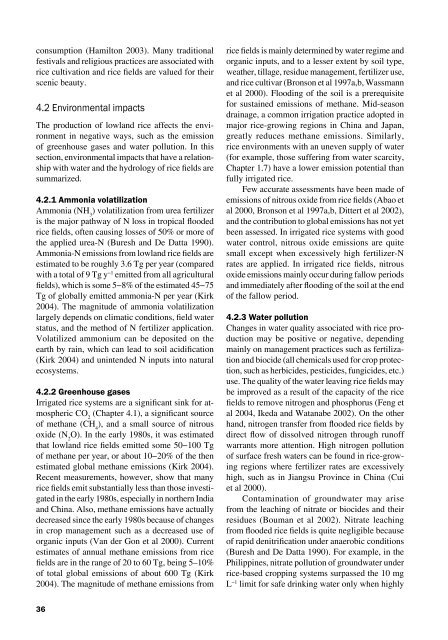


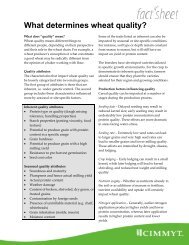

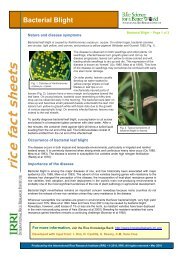

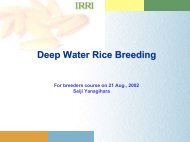
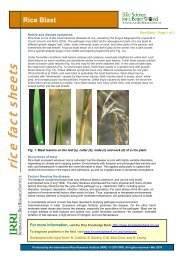
![International Standards' Organization â Rice Specification [ISO 7301]](https://img.yumpu.com/36696862/1/190x245/international-standards-organization-a-rice-specification-iso-7301.jpg?quality=85)

